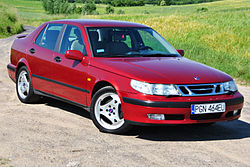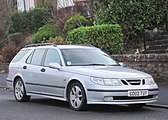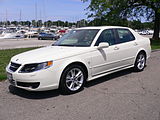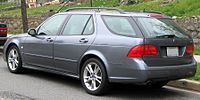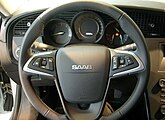Saab 9-5
| Saab 9-5 | |
|---|---|
| Production period: | 1997-2011 |
| Class : | upper middle class |
| Body versions : | Limousine , station wagon |
| Previous model: | Saab 9000 |
The Saab 9-5 was the Swedish car manufacturer Saab -built passenger car model of the upper middle class , which was manufactured by the summer of 1997 until the end of the 2011th It replaced the Saab 9000 , which had been offered since spring 1985, and was initially available as a notchback sedan , and from the beginning of 1999 also as a "Sport Combi" .
The second generation of the 9-5 was introduced in summer 2010. The construction of the new vehicle had already been completed for a long time, but there were delays due to the change of ownership from Saab. Production was interrupted in April 2011 and ended in December 2011. The cause is Saab's bankruptcy and General Motors ' refusal to license the model to Saab's new owner.
9-5 (YS3E, 1997-2010)
| 1st generation | |
|---|---|
|
Saab 9-5 Sedan (1997-2001) |
|
| Production period: | 1997-2010 |
| Body versions : | Limousine , station wagon |
| Engines: |
Otto engines : 2.0–3.0 liters (110–191 kW) Diesel engines : 1.9–3.0 liters (88–130 kW) |
| Length: | 4827-4841 mm |
| Width: | 1792 mm |
| Height: | 1448-1501 mm |
| Wheelbase : | 2703 mm |
| Empty weight : | 1570-1753 kg |
| Stars in the Euro NCAP - Crash Test (1998) |
|
| Stars in the Euro NCAP - Crash Test (2003) |
|
Like the first version of the Saab 9-3 , the 9-5, which was introduced in autumn 1997, is based on the GM2900 platform designed by General Motors at Opel , which was also used in the Opel Vectra B , among others . The chassis is equipped with MacPherson struts at the front and multi-link independent suspension at the rear, each with stabilizers .
With the 9-5, Saab continued the brand's tradition of offering various safety functions in their vehicles. For example, the 9-5 is the first production vehicle to offer seats with active headrests (SAHR, Saab Active Head Restraints), which in the event of a rear-end collision, rest against the heads and thus prevent whiplash and neck injuries, and the first car to offer ventilated seats.
The 9-5 broke with the tradition of the hatchback body with a tailgate. Instead, the SportCombi appeared in spring 1999 as a replacement. The sedan had a drag coefficient (C w ) of 0.29, the station wagon 0.32.
Facelift
In the summer of 2001 the series was revised for the first time. It received clear-glass headlights at the front and brighter indicators and reversing lights at the rear. In addition, two new diesel engines, one with a displacement of 2.2 liters and an output of 88 kW and one with a displacement of 3.0 liters and an output of 130 kW, were introduced. In the following year, the 2.3T was also replaced, which now had 162 kW.
The second facelift in September 2005 included extensive modifications to the vehicle. The front was adapted to the new design line developed on the Saab 9-2X , the bumpers were integrated into the body, and new rear lights and door handles painted in body color were introduced. The chassis was tuned tougher and the dashboard was also largely redesigned (rotary control, individual instruments). All previously used diesel engines (88 and 130 kW, the latter a V6 from Isuzu ) were replaced by an engine (110 kW, from GM-Fiat-Powertrain), which was also used in the 9-3.
The last 9-5 SportSedan was manufactured at the end of June 2009, while the last SportCombi rolled off the production line in February 2010. It is the last of a total of 483,593 copies of the first generation of the 9-5.
General Motors sold tools and rights of use of the first generation of the 9-5 to Beijing Automobile Works , who brought the car to the market as the Beijing Senova D-series with a major visual makeover .
Engines
In addition to various gasoline engines with a displacement of 2.0 to 3.0 liters, there were also three diesel engines on offer, some of which came from a cooperation with Fiat , but vehicles with V6 diesel engines (Isuzu Y30DT or Saab designation D308L) were built up to and including year of construction 2004 known for problems caused by lowering of the cylinder liner, which initially often became noticeable in the form of increased cooling water consumption or jerking of the engine and usually required a complete engine replacement after a few thousand kilometers of driving. In 2005, Saab also presented the 2.0t BioPower model for the first time in the company's history, an automobile that is designed to run on bio-ethanol (E85) or super petrol. All engines are equipped as standard with a five-speed manual gearbox or optionally with a five-speed Sentronic .
| model | Type | Displacement | power | Torque (for automatic) |
Consumption / 100 km (for automatic) |
construction time | |
|---|---|---|---|---|---|---|---|
| Petrol engines | |||||||
| 2.0t | R4, 16V, turbo | 1985 cc | 110 kW (150 hp) at 5500 min -1 | 240 Nm at 1800-3500 min -1 | 8.6 (10.3) l super | 08 / 1997-02 / 2010 | |
| 2.0t BioPower | R4, 16V, turbo | 1985 cc | 132 kW (180 hp) at 5500 min -1 | 280 Nm at 1800-3500 min -1 | 8.6 (10.3) l E85 / Super | 11/2006–02/2010 | |
| 2.3t | R4, 16V, turbo | 2290 cc | 136 kW (185 hp) at 5500 min -1 | 280 Nm at 1800-3500 min -1 | 8.9 (10.0) l super | 12 / 2000-02 / 2010 | |
| 2.3t BioPower | R4, 16V, turbo | 2290 cc | 154 kW (210 hp) at 5500 min -1 | 310 (280) Nm at 1800-3500 min -1 | 8.9 (10.0) l E85 / Super | 11/2006–02/2010 | |
| 2.3 T | R4, 16V, turbo | 2290 cc | 125 kW (170 hp) at 5500 min -1 | 280 Nm at 1800 min -1 | 9.7 l super | 08 / 1997-11 / 2000 | |
| 2.3 T | R4, 16V, turbo | 2290 cc | 162 kW (220 hp) at 5500 min -1 | 310 Nm at 1800 to 4500 min -1 | 8.9 (10.3) l super | 07/2003-08/2007 | |
| 2.3 Turbo | R4, 16V, turbo | 2290 cc | 169 kW (230 hp) at 5500 min -1 | 350 Nm at 1900 min -1 | 9.3 l super plus | 10 / 1999-08 / 2001 | |
| 2.3 Turbo | R4, 16V, turbo | 2290 cc | 184 kW (250 hp) at 5300 min -1 | 350 Nm at 1900 min -1 | 8.8 l super plus | 08 / 2001-08 / 2005 | |
| 2.3 Turbo | R4, 16V, turbo | 2290 cc | 191 kW (260 hp) at 5200 min -1 | 350 Nm at 1900 to 4500 min -1 | 9.1 (10.3) l super plus | 09 / 2005-02 / 2010 | |
| 3.0t V6 | V6, 24V, turbo | 2962 cc | 147 kW (200 hp) at 5000 min -1 | 310 Nm at 2500 min -1 | 11.1 l super plus | 01 / 1998-06 / 2003 | |
| Diesel engines | |||||||
| 1.9 TiD DPF | R4, 16V, turbo | 1910 cc | 110 kW (150 hp) at 4000 min -1 | 320 Nm at 2000 to 2750 min -1 | 6.4 (7.4) l diesel | 12/2005–02/2010 | |
| 2.2 TiD | R4, 16V, turbo | 2171 cc | 88 kW (120 hp) at 4000 min -1 | 280 Nm at 1500 min -1 | 6.6 l diesel | 03 / 2002-08 / 2005 | |
| 3.0 TiD | V6, 24V, turbo | 2958 cm³ | 130 kW (177 hp) at 4000 min -1 | 350 Nm at 1800 min -1 | 7.3 l diesel | 08 / 2001-08 / 2005 | |
safety
In Euro NCAP - Crash test the Saab 9-5 1998 received four out of five possible stars 31 points in the evaluation of occupant safety by adults. This made it the best vehicle in its class tested to date. In terms of pedestrian protection, the tested vehicle achieved 12 points and two out of four possible stars. After the Saab 9-5 was equipped with seat belt warnings for the front seats in June 2003, the adult occupant safety rating was upgraded to 33 points and five out of five possible stars.
The Saab 9-5 (type YS3E) was consistently in the highest safety category from its first designation in the Folksam Report 2003 to 2009, and in 2003 it was only in a special category, which made it the “säkraste bilen” (Swedish for “safest car” ) . In the 2005 report, it was determined to be the safest car together with the Saab 9-3 (type YS3D) .
Awards
- 1998 best imported upper middle class car - Auto, Motor und Sport
- 1999 Swedish Design Award - Swedish Society for Vehicles and Design
- 2001 Best Car ($ 30,000-35,000 Class) - American Automobile Association
- 2003 Safest Car - Folksam (Insurance, Sweden)
- 2005 Safest Car - Folksam (Insurance, Sweden)
9-5 (YS3G, 2010-2011)
| 2nd generation | |
|---|---|
|
Saab 9-5 (2010-2011) |
|
| Production period: | 2010-2011 |
| Body versions : | Limousine , station wagon |
| Engines: |
Otto engines : 1.6–2.8 liters (132–221 kW) Diesel engines : 2.0 liters (118–140 kW) |
| Length: | 5008 mm |
| Width: | 1868 mm |
| Height: | 1467 mm |
| Wheelbase : | 2837 mm |
| Empty weight : | 1725-2065 kg |
| Stars in the Euro NCAP - Crash Test (2009) |
|
development
The plans for a successor to the 9-5 go back to the early 2000s, when Saab developed a platform called Premium with GM and Fiat . The Alfa Romeo 159 (2005–2011) and Alfa Romeo Brera (2005–2010) models were also based on this floor pan.
As early as 2002, GM decided not to use this platform for the second generation of the Saab 9-5. This delayed the new development considerably. Instead, the well-known first-generation 9-5 was updated with two facelifts in summer 2001 and autumn 2005.
The first pictures of the sedan were published in July 2009. Saab first presented the new 9-5 on the company's website on August 27, 2009, before being shown to a wide audience a month later at the IAA .
Due to Saab's economic difficulties, the start of production of the sedan was delayed from autumn 2009 to mid-2010. Prices ranged between 33,700 (1.6T Linear) and around 70,000 euros (2.8T Aero with all currently available equipment) (as of February 2011).
In the course of 2011, production had to be repeatedly interrupted because various suppliers no longer supplied the company with sufficient new parts due to payment arrears.
The start of production of the SportCombi was initially announced for late summer 2011, then postponed to the beginning of 2012. Due to the bankruptcy of Saab and a refusal of licenses by General Motors, the SportCombi, unlike the sedan, was never mass-produced. Only 33 pre-series models were created, which were auctioned by an auction house in Sweden at the end of 2012.
Production, which had been interrupted since April, was ended in December 2011. The cause is the bankruptcy of Saab and the refusal of General Motors to license the model to the new owner of Saab. Of the second 9-5, a total of only 11,280 vehicles were produced.
technology
Like the Opel Insignia A , the Buick LaCrosse and the Cadillac XTS , the new Saab 9-5 was based on the Epsilon II platform from General Motors and was also equipped with their Ecotec II four-cylinder engines (with 1.6 and 2 l displacement , built by Opel in Kaiserslautern) and high-feature V6 engines (2.8 l displacement, built by Holden in Port Melbourne, Australia). The 2.0 diesel engines originally came from Fiat. The engines were installed transversely. The already officially announced 2.0-l diesel engine with two turbos and 140 kW of power was available from model year 2011; a 3.0 l V6 diesel with approx. 170 kW output (developed by VM Motori ) had been canceled by General Motors.
The new model was 17 cm longer than the first generation and now measured 5.01 m, with the wheelbase being almost 11 cm longer than the Insignia. It was built in the Saab parent plant in Trollhättan.
For the chassis, a construction called HiPerStrut was used in certain versions instead of the MacPherson struts normally built in, and a multilink suspension on the rear axle. HiPerStrut is a variant of the MacPherson strut that is also used in the Opel Insignia OPC. In this case, the wheel carrier has its own independent axis, so that the wheel carrier rotates independently of the axis of the spring strut during steering movements. This is intended to reduce the change in the camber during steering, which leads to improved cornering behavior. Further advantages, according to Opel, are improved suspension quality, reduced mass and better steering behavior (no drive influences on the steering).
- Technical specifications
| 1.6T | 2.0T / 2.0T BioPower | 2.8T V6 | 2.0TiD DPF | 2.0TTiD DPF | |
|---|---|---|---|---|---|
| Construction period: | 05/2010–12/2011 | ||||
| Engine type: | Four-cylinder in- line petrol engine | Six-cylinder V-type gasoline engine | Four-cylinder in-line diesel engine , common rail injection | ||
| Engine charging : | turbocharger | ||||
| Displacement: | 1598 cc | 1998 cc | 2792 cc | 1956 cc | |
| Max. Performance in min -1 : | 132 kW (180 PS) / 5500 | 161 kW (220 PS) / 5300 | 220 kW (300 PS) / 5500 | 117 kW (160 PS) / 4000 | 140 kW (190 PS) / 4000 |
| Max. Torque at min -1 : | 230 Nm / 2200 | 350 Nm / 2500 | 400 Nm / 2000 | 350 Nm / 1750 | 400 Nm / 1750 |
| Drive type, standard: | Front wheel drive | all wheel drive | Front wheel drive | ||
| Drive type, optional: | - | All-wheel drive XWD | - | All-wheel drive XWD | |
| Gear type, standard: | 6-speed manual transmission | 6-speed automatic transmission | 6-speed manual transmission | ||
| Gear type, optional: | - | 6-speed automatic transmission | - | 6-speed automatic transmission | |
| Empty weight: | 1725-1990 kg | 1945-2065 kg | 1725-1915 kg | ||
| maximum payload: | 370-545 kg | 375-495 kg | 365-445 kg | ||
| Acceleration, 0-100 km / h: | 9.5 s | 7.9-8.8 s | 6.9 s | 9.9-10.1 s | 8.8-9.2 s |
| Top speed: | 220 km / h | 230-240 km / h | 250 km / h (governed) | 209–215 km / h | 220-230 km / h |
|
Fuel consumption over 100 km (combined): |
7.8 l super | 8.2–9.9 l super | 10.6 l super plus | 5.3–6.8 l diesel | 6.0–6.7 l diesel |
| CO 2 emissions, combined: | 179 g / km | 189-228 g / km | 244 g / km | 139-179 g / km | 159-176 g / km |
| Emissions standard according to EU classification: | 5 euro | ||||
Equipment
The following equipment, some of which were already known from the Insignia, were available:
- Harman Kardon audio system
- Head-Up Display
- a camera-based lane change assistant / lane keeping assistant with traffic sign recognition for speed restrictions and no overtaking
- Seats not only heated, ventilated and with SAHR (like in the old 9-5, but 3rd generation), but also adjustable in hardness
- a cargo system that has a lock to prevent luggage from slipping into the deep trunk
- three separately adjustable climate zones
- Fold-out screens in the back of the front seats, with connection options for multimedia devices such as DVD players and game consoles
- A round LC screen in the central display instrument for displaying various functions (e.g. recognized traffic signs, additional speed display in the style of a PFD )
- adaptive headlights , which in mountain / downhill and the vehicle inclination adapts
- adaptive cruise control
- Parking assistant (without interfering with the steering wheel movement)
- adaptive chassis control
- electric handbrake
The chassis control used inputs from sensors for speed, braking force, speed of the brake pedal actuation, engine power output and lateral acceleration to determine driving situations, each of which includes profiles for setting the damper hardness, the response of the accelerator pedal, the characteristic curve of the power steering assistance, the intervention threshold of the ESP, the reaction time of the cornering light , the switching time (automatic), and the torque distribution (all-wheel drive).
safety
A total of 110 vehicles were used in 71 different test situations in crash tests in order to optimize the 9-5's collision behavior. A gyro sensor detects a rollover of the vehicle in order to trigger the side head airbags in this case as well . Tests were also carried out on collisions with moose simulators. In the Euro NCAP crash test, the new 9-5 received five out of five possible stars at the end of 2009. In the assessment of the occupant safety of adults, the tested vehicle achieved 94% and in the occupant safety of children 80% of the maximum possible number of points. In the area of pedestrian protection, the vehicle received 44% of the points, the standard equipment with supporting safety systems was rated with 86% of the possible number of points.
statistics
New registrations in Germany
The annual new registrations of Saab 9-5 in Germany are listed every year since 1999 according to statistics from the Federal Motor Transport Authority .
| year | 1999 | 2000 | 2001 | 2002 | 2003 | 2004 | 2005 | 2006 | 2007 | 2008 | 2009 | 2010 | 2011 |
|---|---|---|---|---|---|---|---|---|---|---|---|---|---|
| number | 3,803 | 3,280 | 3,777 | 2,553 | 1,874 | 1.317 | 1,130 | 986 | 579 | 373 | 201 | 206 | 157 |
| change | - 13.8% | + 15.2% | - 32.4% | - 26.6% | - 29.7% | - 14.2% | - 12.7% | - 41.3% | - 35.6% | - 46.1% | + 2.5% | - 23.8% |
Web links
Individual evidence
- ↑ a b Saab 9-5 (1998). Euro NCAP, accessed July 22, 2014 .
- ↑ a b Saab 9-5 (2003). Euro NCAP, accessed July 22, 2014 .
- ↑ Saab 9-5 brochure from Saab Germany, model year 1999
- ↑ Archived copy ( memento of the original dated November 9, 2012 in the Internet Archive ) Info: The archive link was inserted automatically and has not yet been checked. Please check the original and archive link according to the instructions and then remove this notice.
- ↑ Understatement with a turbo kick. AutoScout24 , March 27, 2006, accessed May 7, 2012 .
- ↑ Final Saab 9-5 Production Model Rolls Off Assembly Line . SaabHistory.com. July 3, 2009. Retrieved February 9, 2011.
- ↑ Final Saab 9-5 SportCombi Model Rolls Off Assembly Line . SaabHistory.com. February 1, 2010. Retrieved February 9, 2011.
- ↑ http://saab-rover-blog.net/2011/03/29/der-katastrophen-kloter-saab-9-5i-3-0-tid/
- ↑ Hur säker är bilen? 2003. (PDF) (No longer available online.) Folksam, 2003, archived from the original on March 4, 2016 ; Retrieved July 22, 2014 (Swedish). Info: The archive link was inserted automatically and has not yet been checked. Please check the original and archive link according to the instructions and then remove this notice.
- ↑ Folksams nya rankning ”Hur säker är bilen?”: Risken att dö i moderna bilar har minskat med 90 percent. Saab 9–5 och 9–3 säkrast. (PDF) Folksam, April 21, 2005, accessed September 29, 2014 (Swedish).
- ↑ a b Saab 9-5. Euro NCAP, accessed July 22, 2014 .
- ↑ Saab 9-5 - 20 nya pictures! (No longer available online.) July 24, 2009; Archived from the original on July 28, 2009 ; Retrieved July 28, 2009 (Swedish). Info: The archive link was inserted automatically and has not yet been checked. Please check the original and archive link according to the instructions and then remove this notice.
- ↑ Price list for the new 9-5 from www.saab.de
- ↑ The Dutch Saab majority owner Spyker Cars is in talks with suppliers about payment and delivery terms. . Retrieved June 12, 2011.
- ↑ It's fat, man! AutoBild , August 27, 2009, accessed July 22, 2009 .
- ↑ [1]
- ↑ Saab goes into bankruptcy: Saab throws in the towel autobild.de, December 19, 2011
- ^ "Shocked" Brightwell drops Saab bid, blames GM intransigence. February 28, 2012, accessed February 29, 2012 .
- ↑ It's not a question of money! February 29, 2012. Retrieved February 29, 2012 .
- ↑ saab-rover-blog.net
- ↑ TTELA drive the 2010 Saab 9-5
- ↑ Saab 9-5: The inside story. Retrieved July 1, 2009 .
- ↑ Saab 9-5 (2010) disguised as a Vectra. August 8, 2007, accessed May 18, 2009 .
- ↑ Insignia VXR HiPerStrut Technical Description and Detail
- ↑ http://www.saabsunited.com/2009/09/offcial-release---2010-saab-9-5-introduction-and-design.html ( page no longer available , search in web archives ) Info: The link was automatically marked as defective. Please check the link according to the instructions and then remove this notice.
- ↑ Information from the iPhone app for the 9-5.
- ↑ PDF at www.gmeurope.info
- ↑ [2]
- ↑ a b Segmentation of passenger cars 1999/2000. (PDF) Federal Motor Transport Authority, archived from the original on November 24, 2005 ; Retrieved July 22, 2014 .
- ↑ Segmentation of passenger cars December 2001 (PDF; 89 kB) Kraftfahrt-Bundesamt, accessed on July 22, 2014 .
- ↑ New registrations of passenger cars by segment and type group as well as with diesel drive in December 2002. (PDF; 108 kB) Federal Motor Transport Authority, accessed on July 22, 2014 .
- ↑ New registrations of passenger cars by segment and type group as well as with diesel drive in December 2003 (PDF; 115 kB) Federal Motor Vehicle Office, accessed on July 22, 2014 .
- ↑ New registrations of passenger cars by segment and model series in December 2004. (PDF; 108 kB) Federal Motor Transport Authority, accessed on July 22, 2014 .
- ↑ New registrations of passenger cars by segment and model series in December 2005. (PDF; 141 kB) Federal Motor Transport Authority, accessed on July 22, 2014 .
- ↑ New registrations of passenger cars by segment and model series in December 2006. (PDF; 177 kB) Federal Motor Transport Authority, accessed on July 22, 2014 .
- ↑ New registrations of passenger cars by segment and model series in December 2007. (PDF; 157 kB) Federal Motor Transport Authority, accessed on July 22, 2014 .
- ↑ New registrations of passenger cars by segment and model series in December 2008. (PDF; 280 kB) (No longer available online.) Federal Motor Transport Authority, archived from the original on May 31, 2014 ; Retrieved July 22, 2014 . Info: The archive link was inserted automatically and has not yet been checked. Please check the original and archive link according to the instructions and then remove this notice.
- ↑ New registrations of passenger cars by segment and model series in December 2009. (PDF; 355 kB) (No longer available online.) Federal Motor Transport Authority, archived from the original on February 14, 2015 ; Retrieved July 22, 2014 . Info: The archive link was inserted automatically and has not yet been checked. Please check the original and archive link according to the instructions and then remove this notice.
- ↑ New registrations of passenger cars by segment and model series in December 2010. (PDF; 2.0 MB) (No longer available online.) Federal Motor Transport Authority, archived from the original on May 31, 2014 ; Retrieved July 22, 2014 . Info: The archive link was inserted automatically and has not yet been checked. Please check the original and archive link according to the instructions and then remove this notice.
- ↑ New registrations of passenger cars by segment and model series in December 2011. (PDF; 2.1 MB) (No longer available online.) Federal Motor Transport Authority, archived from the original on May 31, 2014 ; Retrieved July 22, 2014 . Info: The archive link was inserted automatically and has not yet been checked. Please check the original and archive link according to the instructions and then remove this notice.
